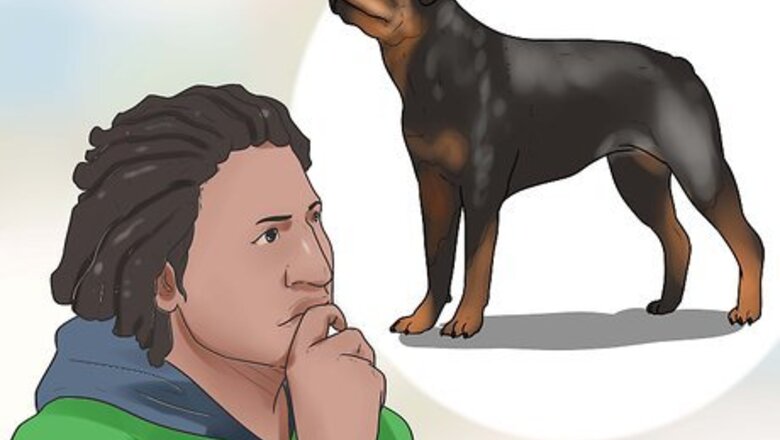
views
X
Research source
They are loyal, intelligent and affectionate dogs that are found throughout the world.[2]
X
Research source
In part because of unscrupulous breeders, the Rottweiler has recently gotten the reputation as an aggressive pet. If you train your Rottweiler properly your pet will be less likely to be aggressive and instead provide much love and fun to you and your family.
Understanding Rottweilers and Their Training Needs
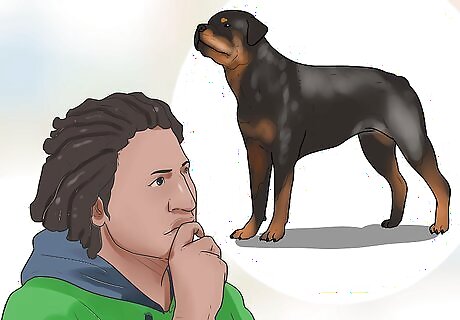
Learn about the breed. Any person who owns a Rottweiler should have a good basic knowledge about the breed. Not only will this help you train your Rottweiler properly, but also keep it happy and healthy. Well-bred Rottweilers are large and athletic. Male Rottweilers can grow up to 27 inches tall at the shoulder and weigh 100 – 135 pounds. Female Rottweilers are slightly smaller: up to 25 inches tall at the shoulder and weighing 80 – 100 pounds. Rottweilers have a thick, glossy black coat with tan patches on the body. You should brush the coat every few days to keep it glossy and healthy. Rottweilers were originally bred to herd cattle, protect their owners and guard resources. Because of this, they got the name “butcher’s dog.”
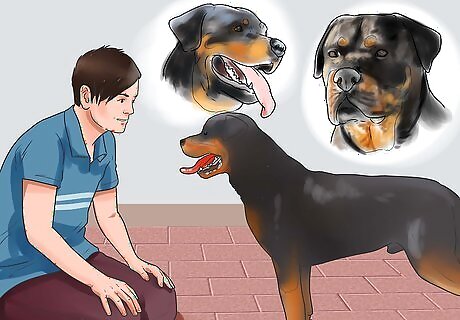
Understand the temperament of Rottweilers. Before you can train your Rottweiler, it’s important to learn about the temperament of the breed. While they are loyal and loving, they can also be aggressive. Understanding your Rottweiler will help you successfully train it. Rottweilers are very social animals and bond well with their human family. They don’t like to be left alone or isolated. It’s not uncommon for them to have separation anxiety. Rottweilers need a lot of physical and mental stimulation. Long walks and obedience training sessions will stimulate them and help prevent destructive behaviors such as digging, chewing, and whining. Rottweilers are naturally territorial and will be very protective of you. Rottweilers may act dominantly towards other animals and people. Proper training, which includes socialization, will help minimize this behavior. Rottweilers may exhibit aggressive behavior if they are trained that this is acceptable behavior or if they are not trained properly. Rottweilers reach maturity very slowly, usually at the age of two. This can mean they will be hyperactive and mischievous for a longer period than other dogs. They may also chew on articles more frequently until they reach maturity.
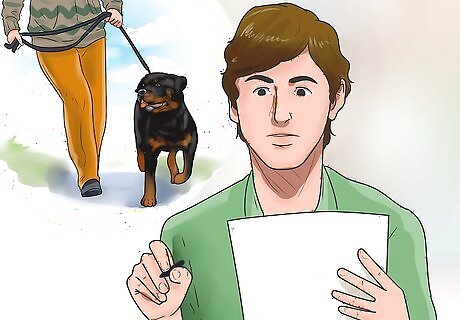
Make a training plan. Develop a training plan that you can follow consistently. Making a plan will give you a chance to consider your dog’s personality and different factors that may affect the process, such as if your Rottweiler is older or a puppy. When developing your training plan, make sure to keep your Rottweiler’s personality in mind. If there are certain areas of behavior with which he has difficulty, focus on those. Since training is something you need to do regularly and over time, set short, mid and long term goals. You can develop your plan by setting daily, weekly, and monthly intentions or goals for you Rottweiler. By taking the time, if necessary, to teach your dog lessons, you will ensure that your dog is obedient and understands the lessons you’ve taught him. For example, you could have the goal one week of socializing your Rottweiler. Make a plan over the course of the week to expose your dog to other dogs and people. Remember to keep the activities short, like a walk to the dog park, followed by a reward if your Rottweiler behaves and then walk or run home. It’s important that you can commit ample time over a longer period to training your Rottweiler. Dog training doesn’t happen overnight and requires consistency.
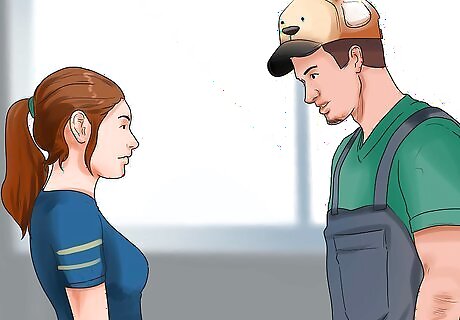
Consider a professional trainer. If you don’t have the time to commit to training your Rottweiler consistently and properly or if your dog is having specific issues, consider hiring a professional trainer. Often, a professional will be able to address an issue that you cannot. Professional trainers will ensure your dog is obedient, but you will still need to use commands consistently and undertake top up training so as to keep it fresh in the dog's mind. If you have an older Rottweiler or even a rescue that has been traumatized, they may have specific behavioral issues that need addressed by someone who understands how to handle these situations. Learn from the trainer what your problems are and the solution, so you can apply this consistently at home. Puppies may also be averse to training and require professional training. You may also want to use a professional to help reinforce your training methods and correct you where you are having difficulties. Consult the local chapter of the American Kennel Club or the AKC’s website to find obedience training programs for your Rottweiler.
Training Your Rottweiler
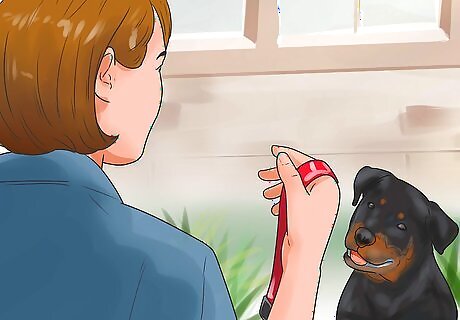
Start training your dog as soon as possible. In order to train your Rottweiler most effectively, you want to start training him as early as possible to establish acceptable behavior. From puppies to older dogs, Rottweilers respond well to training with the proper guidance from early on in your relationship. Start training immediately. No matter how old your Rottweiler is, you will be most successful if you start training him early. You will be most successful if you train your Rottweiler between the ages of 6 weeks and 6 months. If you got your Rottweiler at an older age, it’s important to not be discouraged. You can train him as soon as he joins your family. Just know that it may take a little more time, effort, and patience on your part. Remember that Rottweilers are intelligent, obedient, and loyal companions that want to make you happy. Proper communication with your Rottweiler will help you to train him at any age.
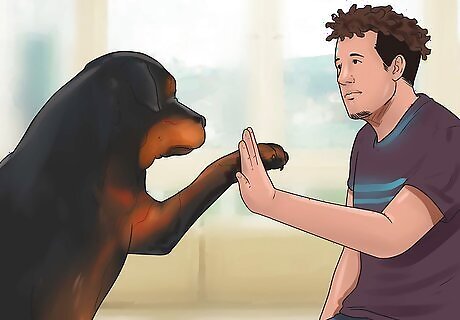
Understand dominance. When you train your Rottweiler, you want to establish rules that he will follow so that he behaves properly. By understanding that dominance in the relationship with your Rottweiler doesn’t mean dominating him, you are more likely to encourage the behaviors you seek. Dominance means establishing rules your Rottweiler will follow by reinforcing them with a firm voice or hand motions that indicate he is a member of a pack that you lead. You can be dominant and firm while being kind and careful with your Rottweiler. For example, the best way to establish this dominance is to take your Rottweiler for a walk on a leash and have him heel beside or behind you. Don’t dominate your Rottweiler through verbal or physical aggression. This will will only cause him to fear you and undermine your training plan.
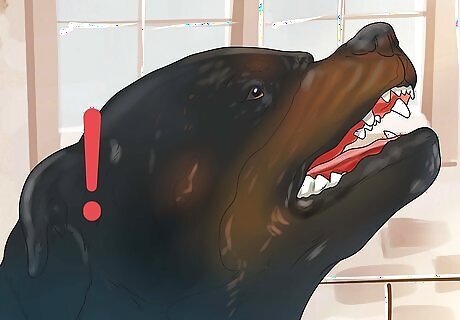
Identify and manage aggressive behavior. Rottweilers can exhibit aggressive behavior at any age. Rottweilers can get aggressive with people and other dogs. Identifying aggression and actively managing it with training can help prevent your Rottweiler exhibiting this behavior in the future. A Rottweiler may not show aggression immediately because he is an observer by nature. The signs of aggression may be discreet and your Rottweiler may even seem calm. Ignoring even subtle signs of aggression, such as staring, can lead to later problems. There are different signs of aggression in a Rottweiler including a low growling noise, showing teeth, snapping the jaw, or staring. If you see your Rottweiler quietly staring at something, this is a sign of aggression. Remove him from the situation to calm him down and avoid potential problems. A Rottweiler will exhibit aggression for different reasons such as protecting his territory, as well as being territorial with food or with an owner. A Rottweiler may show aggression towards other dogs, such as growling or barking, because he thinks he is protecting you. Fear is a primary reason of aggression in Rottweilers. It can be a trained behavior. For example, if a man with a beard verbally or physically punished your Rottweiler, this may have traumatized him and he may exhibit aggressive behavior when he sees any man with a beard. Manage aggression by quickly neutralizing the situation in a calm manner. If you get upset with your Rottweiler, you may compound his anxiety and aggression. Manage your Rottweiler’s aggression by exposing him to triggers in a controlled environment. This will help reduce his fear and help minimize aggressive behaviors. For example, if your Rottweiler fears men with beards, have him meet a friend or family member who loves dogs and can show your Rottweiler that he doesn’t need to be scared of everyone with facial hair. If your Rottweiler if exhibiting aggression towards you, leave the situation and don’t confront your dog. Never chastise a Rottweiler for growling. This will inhibit the behavior (growling) but not remove his underlying feelings of tension. Thus the dog may learn to bite without first warning of his intention because he feels inhibited about growling.
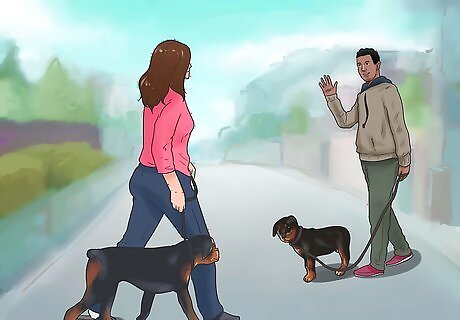
Socialize your Rottweiler. One important component of training your Rottweiler is exposing him to other dogs and people. This will keep him happy and comfortable in any situation, and less likely to be aggressive. It will also make him more receptive to your training. Rottweilers may act dominantly towards other animals and people and this behavior can be prevented with proper socialization. Help your Rottweiler be comfortable around both dogs and people by exposing him to positive situations with other dogs and individuals. Socialize your Rottweiler by taking him for walks, to play the dog park, and to visit friends. It’s also important to invite people to your house so that your Rottweiler is comfortable having people on his territory. Keep every aspect of socialization calm and positive, which will teach your Rottweiler to be calm and confident.
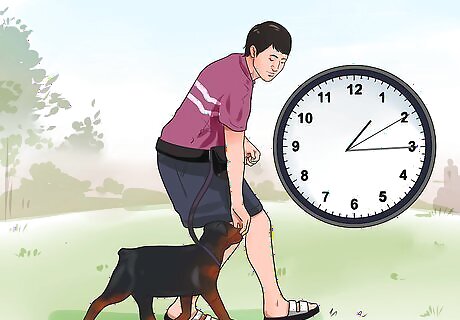
Keep training sessions short. Dogs have a very short attention span and a short memory, so keep training sessions short. Combine training sessions with activities such as socialization and mealtimes. Keep training sessions at about 15 minutes. Know that Rottweilers distract easily, so be patient if your dog makes a mistake. Combining training sessions with other activities is a great method to reinforce the lessons you’re teaching. For example, if you have your dog at the park, it’s a good way to teach him commands such as “come.”
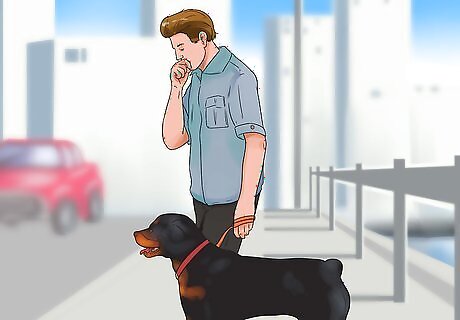
Be patient with your Rottweiler. Patience is the most important and hardest part of training a Rottweiler. Remember that your dog wants to please you. If you are calm and happy, your Rottweiler will be calm and happy. You will be most successful at training your Rottweiler if you are patient with him. If you keep the training fun for both you and your Rottweiler, you’re more likely to be patient with him. Training for any dog is a lifelong process. Yelling or physical punishment will only counteract your training process, and also may cause your dog to fear you and other people.
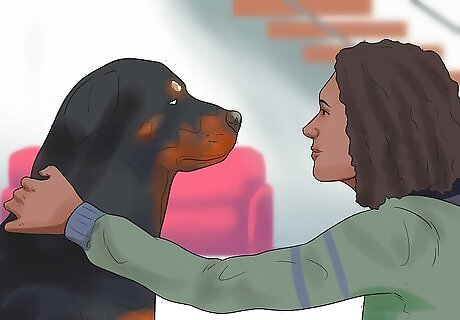
Use positive reinforcement and avoid physical discipline and yelling. Rewarding your dog for his positive behaviors is an integral part of the training process. Understand that your Rottweiler will make occasional mistakes and that you must avoid physical discipline or yelling at him in these situations. Positive reinforcement trains your dog by rewarding the actions you want him to repeat. Reward your Rottweiler with treats, toys or praise. When you are teaching him a command and he performs it well, immediately give him his reward. Be careful with food rewards so that your Rottweiler doesn’t get fat or become unhealthy. Rottweilers are going to make mistakes and you should never use physical discipline during training. If your Rottweiler doesn’t perform a command, take a break and then ask him perform it properly. You can reward him after he follows the command to your liking. It is counterproductive to verbally or physically punish your Rottweiler. This will only cause him to be fearful and confused and may even discourage him from learning the command.
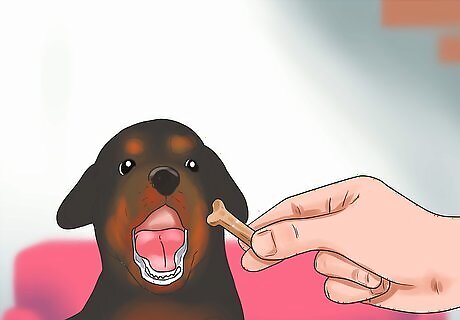
React to behaviors promptly. Because Rottweilers have short term memories and are distracted easily, it’s important to react to your dog’s behaviors promptly. You will reinforce your training methods by doing this, and also ensure that your Rottweiler doesn’t fear because you disciplined him for a behavior that he can’t remember. For example, if your Rottweiler does something you like, such as following a command, it’s important to reward him immediately so he understands that this is the type of behavior you like. Don’t punish a Rottweiler for going to the bathroom in your home unless you see him do it. He won’t remember the behavior. If you do see him go to the bathroom in your home or another inappropriate place, a firm “no” is all that is necessary to teach him this behavior is wrong.
Teaching Commands and House Training
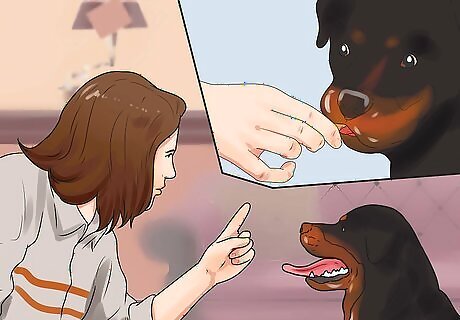
Teach your Rottweiler simple commands. In order to complete your Rottweiler’s training, teach him simple commands by using positive reinforcement. This will help ensure that you have an obedient and well-behaved Rottweiler. Use short one or two word commands together with hand signals so that your dog understands your command voice and the motion he needs to make.
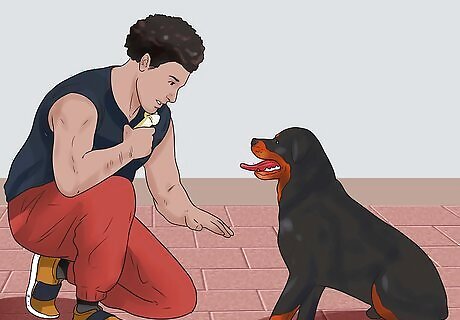
Teach your dog to sit. “Sit” is the first command to teach your Rottweiler because it will make activities like feedings and grooming much easier. Get your dog to focus his attention on your hands so that he is more likely to listen to the command. Say sit and lightly push his behind to get him to sit. Hold a treat in front of your dog’s nose and guide her into a sitting position. When her bum hits the floor say “yes” or “good job” and give her the treat. Repeat this process until your dog follows the command.
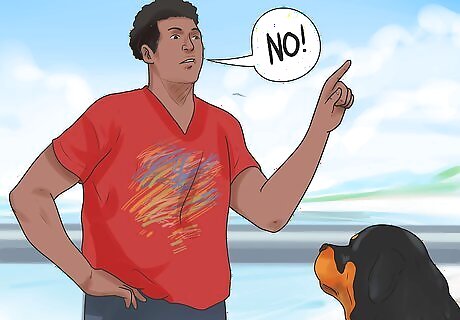
Teach your dog the command “no.” “No” is an important command to teach your dog so they know when they are doing something wrong. Make sure to use “no” in your disciplining voice and don’t overcomplicate it with words your dog won’t understand. Your disciplining voice should be firm and lower toned. To teach “no”, place a treat on the floor and when your dog tries to eat it, make a loud noise and remove the treat. If you repeat this, your dog will associate taking the treat with a startling sound and not try the behavior. You can reinforce this lesson by asking him to sit, for example, and following it up with a treat. Only use this command when you catch your dog doing something bad. Move on when he stops or say it again and remove him from the situation.
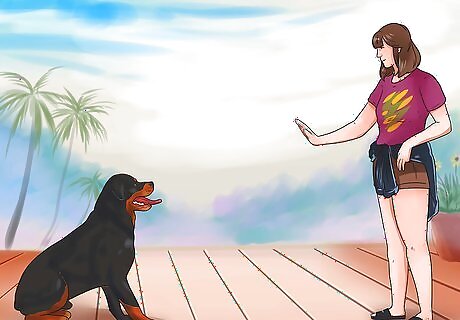
Teach your dog to “stay.” Once you’ve taught your Rottweiler to sit, you can teach him the command “stay.” This is one of the more frustrating commands to each and requires a lot of patience. Don’t get discouraged with teaching this command. Remembering that Rottweilers are social and want to be with you will help you stay patient with your dog. Call your over to a space where you’d like them to stay. Then move away and say “stay” and toss them a treat. Repeat this over the course of a few days. Make sure to reward him when he follows the command properly.
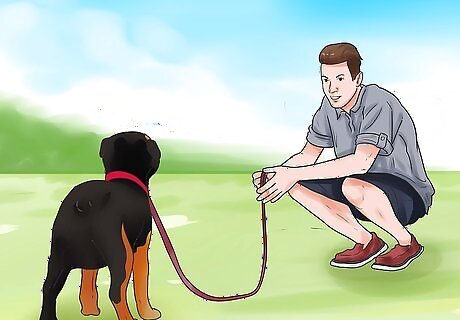
Teach your dog to “come.” You can teach your Rottweiler the most fun command after they’ve learned to stay. Your Rottweiler will also love this command because it means that he can be with you, something this loyal and social breed loves. For example, have your family members call your dog from around a room by saying his name and “come!” Encourage your Rottweiler to come by clapping, or making other noises she likes. When she comes to you or your family members, say “good boy” and give him a tasty treat. Then someone else can call him. Make sure to reward him when he follows the command properly. When training, always release your Rottweiler after he's followed the command. This will show him that the "come" command doesn't always mean play times over.
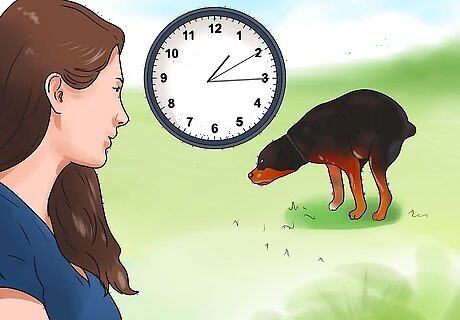
House train your Rottweiler. Housebreaking a dog can be one of the most frustrating aspects as an owner, but a very necessary activity. But with consistency, patience, and some positive reinforcement, you can housetrain your Rottweiler with relative ease. Be consistent with taking your Rottweiler outside. Puppies need to be taken out every 20 – 30 minutes during the day and adults should be taken out every hour or two. Take her to an area that you’ve designated their “potty spot” and with her leash on, say “go potty.” Keep encouraging her until she goes and then give her huge praise and a treat to let her know that she’s done a good job. Take your Rottweiler back inside as soon as she’s done going to the bathroom so she knows that going outside means she needs to go to the bathroom. Repeat this process every hour or two until your Rottweiler is housebroken. Don’t worry if your dog does not go to the bathroom right away or at all. She may not have to go. Just keep repeating the process until she’s house trained. Your dog will inevitably make a mess during the housetraining process. When this happens take her outside to the potty spot. Then thoroughly clean up the mess to remove any lingering odor that would draw her back. Do not punish the dog for going to the toilet indoors after the event, as she will link the punishment to you rather than the action. Whatever you do, never yell at or hit your Rottweiler for making a mess, which may make them continue going to the bathroom inside your home.
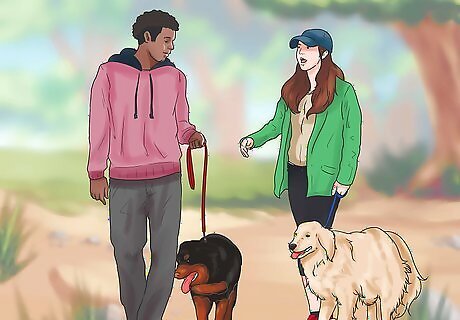
Train your Rottweiler not to bite, bark, or jump on people. In general, obedience training will help ensure that your Rottweiler doesn’t bite, bark, or jump on people. Properly socializing your dog and telling them “no” when he’s done something he wasn’t supposed to will help avoid these behaviors immensely, but there are a couple of other tips you can use, too. You can minimize digging, chewing, whining and many other destructive behaviors through leash walks and by giving dogs chew toys. If your Rottweiler exhibits undesirable behavior such as above, distract him with a squeaky toy to divert his attention. A short "No" is acceptable, immediately before the distraction, so he begins to understand right from wrong. However, be aware that chastisement can be an accidental reward (your attention) so the dog may be more (not less) likely to repeat the behavior in order to get your attention. If they do not stop the behavior, remove them from the situation.




















Comments
0 comment